UB writings























A book of little stories for nieces and nephews. (C) 1994 Ed Mizanoski
Don’t forget to comment below! Share this URL with others: http://bit.ly/ubbook

CONTENTS

DEDICATION

THE RARY







John McCormack – It’s A Long Way To Tipperary is a very famous song.
THE 3-LEGGED CHICKEN


MOTOR, THE TALKING WORM





DON’T THROW STONES



THE FOO-FOO BIRD





EPILOGUE


A UB favorite: Out in the Country
Seph’s Confirmation name is Edward.
It was a spectacular day, and the U.S.S. Zoso, my little fishing boat was going to go exploring Lake Grapevine. Zoso has already done a handful of outings to Lake Lavon, and dozens on Lake Travis. But she was itching to get out on the lake nearest where she is dry-docked (my apartment). Here’s a nice picture of the U.S.S. Zoso.
Zoso did not expect to do much except putt around, but it turned out that she discovered, quite by accident, the Denton Creek inlet. Below is a Google map of the cruise. Zoso started at Katie Woods dock and ended deep into “Deliverance” territory on a river west of Highway 377!

Captain “Jimmy Page” was at helm today and here is the obligatory self-E.

The Zoso spent most of the day exploring the shoreline (no pictures) but she wanted to go as far north as possible just to say she did! There was plenty of gas. Zoso got there and it started getting about 8 ft and a lot of trees. There had been a recent rainy spell and they were submerged. Yet still Zoso pushed on.

But wait what is this little channel? Lets follow it! It can’t go back that far… but it did! And boy did it. We almost called it a day, but the channel led us all the way back another 2 hours! There were a few fishing boats up the channel, but then I came across Trophy Club Park where there was a FREE boat ramp. Finding a free boat ramp made it allworth it.
I powered past Trophy as far as Zoso would take me. We saw a bunch of kids fishing and swimming on the banks. The minimum depth was 10-20 feet – good enough for Zoso. Deep enough that is, until the river widened out and suddenly went to 2-3 ft. My prop was sputtering, and The Wreck of the Edmund Fitzgerald began playing in the background. But my expert care and maintenance of my Johnson powered us out. Yay Zoso! I headed back. But as soon as we got going, we ran out of gas!

Of course, I had a second tank and hooked it up and continued. The river was very narrow, but deep, so I gunned the engine and had a blast racing out of Denton Creek past the kids and fishermen, leaving a big wake! Bad Zoso, bad!
Eventually we made it back on open water and went full speed all the way back to the Katie Woods ramp. When the sun was going down, there was a required stop to drink a required beer and to listen to the required Led Zeppelin album while drinking the said required beer. Houses of the Holy was the selected album this time. My favorite Zepp tune is probably The Rain Song, and it really accented the sunset nicely.


All good days must come to an end. Zoso was happy and so was I. Mission accomplished.

On the way back, we revisited a potential scuba dive site. Looks like there is some good fishing there.

Stats: Max Depth 55ft. 12 gallons of fuel used. 7 hours, 26 miles round trip. Signing off from Lake Grapevine, over and out.
Capt. Page says, “Check out the RSS and audio science podcast feeds below, matey.“







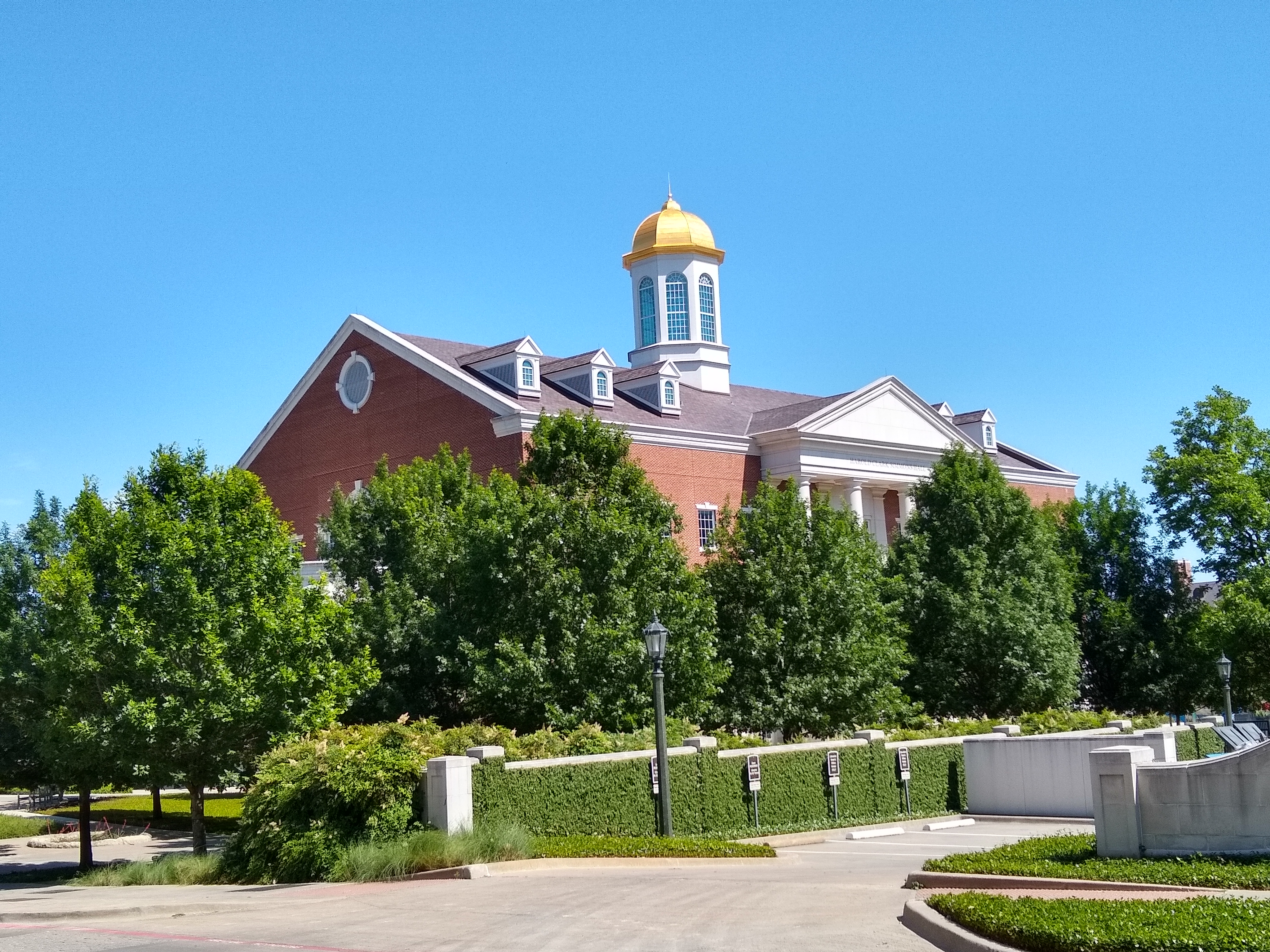





Have you ever discovered something on your own, completely on your own, and years later you find that someone invented it? You’ll say to yourself, “Hey, I invented that first!” Of course, nobody will believe you, and sometimes you will doubt yourself. But there will be times when there is real evidence when you did! Has this ever happened to you? It’s happened at least four times with me, and here are those times.

Using super glue to close a cut on a finger
Crazy glue to close wounds. When I was a kid in the 1970’s, I used to use that super glue to stop myself from bleeding from cuts and scrapes. My mom would freak out of course. Many years later, she hears that they are using it in surgery and brags to her friends that her son had discovered that! Thanks Mom!

An example of carbon monoxide detectors commonly available today.
Carbon monoxide detector. At Rose-Hulman, there is a short one credit course where you design something. My proposal was a carbon monoxide detector that was based on infrared spectroscopy. Many years later my then roommate Aaron told me that I had really invented the now ubiquitous First Alert type carbon monoxide detector. It was nice to get credit because my instructor wasn’t a scientist and didn’t “get it”. Thanks Aaron!

Software uses patterns like dependency injection just like carpenters use city building codes to frame a house. (IoC = inversion of control)
Dependency injection. In 1997, I developed a C++ framework for a secret intelligence project which later was called dependency injection by Ron Johnson from Spring fame. Years later, my then supervisor Cameron told me that my framework was highly reused and extended. I suppose many programmers independently discovered the DI pattern, since it was a natural step at the time, but still, thanks Cameron!

Optical tweezers are the way you can use lasers to hold very tiny pieces of stuff in one place… its discoverer won the 2018 Physics Nobel Prize.
Optical tweezers. Click here for my 1991 Original Proposal from Case-Western Chemistry Ph.D.
This one invention/discovery is the one I’m most proud of, but it is a bit esoteric. I am a protein crystallographer by training (M.S. UCLA) and at the time some of the best crystallographers (e.g. Rossman) was crystallizing whole viruses. This was huge because then the detailed atomic structure becomes available and pharmaceutical companies can then design drugs, and so much more! But it is not easy to get those viruses to crystallize in the first place!!
A part of the Ph.D. process at CWRU was to think up with an entirely new idea and present it to a committee and they judge it. Mine was in 1991, and it was based on the idea of optical tweezers. Essentially, you take a bright laser and focus it, and it forms a trap that holds particles in it still and steady. I was amazed then and applied the concept of optical tweezers to holding the viruses in place using an interference pattern; holding them still in arrays would promote crystallization. I presented my idea to my committee and I passed into Ph.D. candidacy. See above link for the write-up of the proposal.
I was very excited about the idea, but my committee was “meh”. So I didn’t pursue it, not that my CWRU advisor (Klopman) would let me… he didn’t do crystallography (he was doing early chemical AI stuff). So I shelved the idea.
Now fast-foward to 2018, when the Nobel Prize in Physics went to the discoverer of the optical tweezers! This immediately made me find my CWRU original proposal and read it. I had about 10 references to the Nobel Prize Winner. This made me wonder whether my proposal 27 years ago was REALLY a good idea!?! I emailed my UCLA advisor (Eisenberg) with a copy and he simply replied “You were ahead of your time.” My UCLA Advisor is one of the toughest minded people I have ever met, and for him to say such a comment carried a huge weight for me. So I rushed to the literature and discovered that MANY papers now exist which use optical tweezers to crystallize. I was the FIRST to recognize the possibility! WOW! Too bad I didn’t show my UCLA advisor my original proposal in 1991. I had the right stuff then, and I was exactly at the leading edge and looking past it. How satisfying! Thanks, Prof. David!
Below is my written out case I was going to present at trial, but…
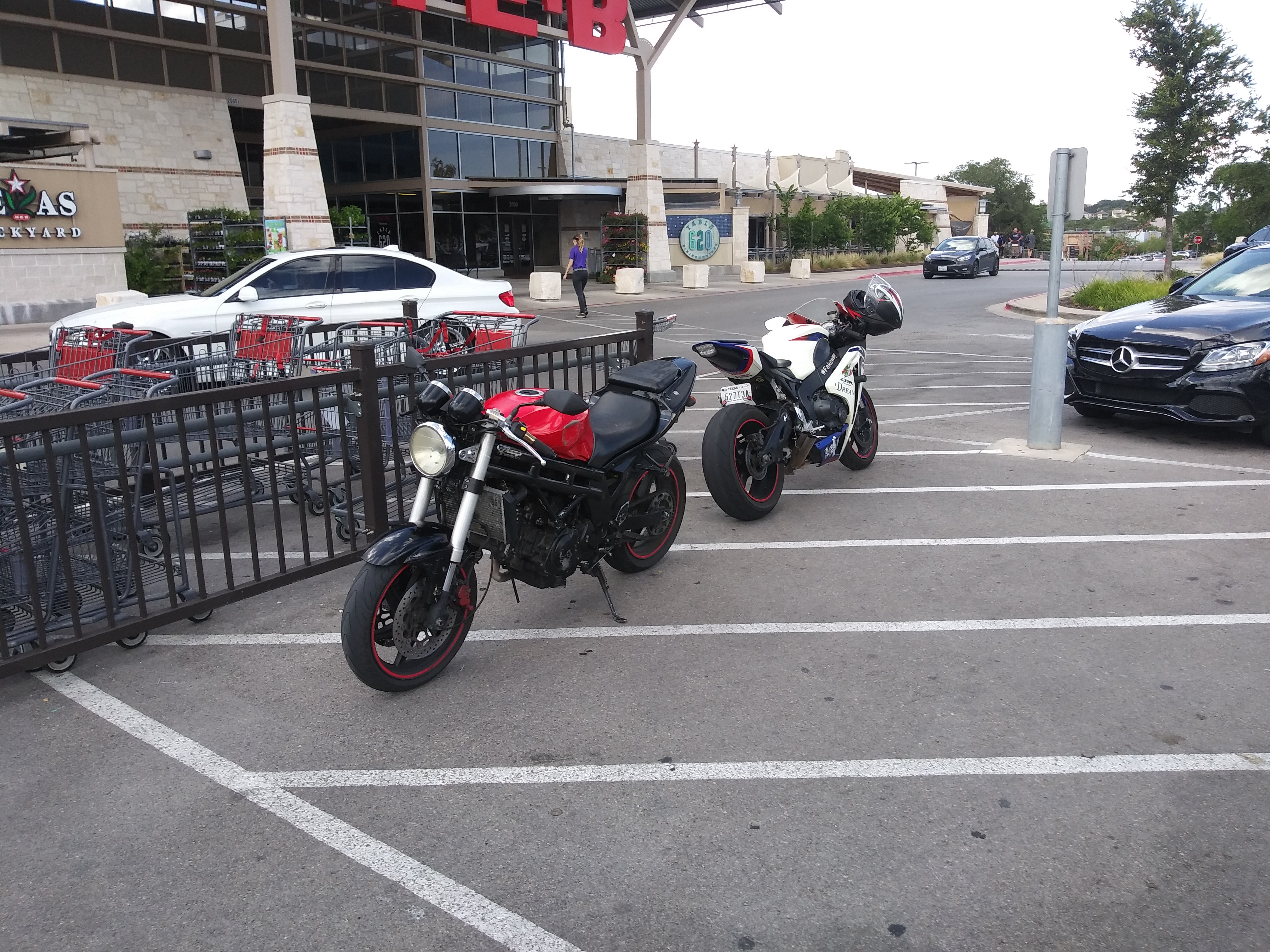
EXHIBIT 1
Hello. My name is JT, age 51, a resident of Travis County since 2014. I have a clean record.
On Saturday, May 26, 2018, at 10:19am, Memorial Day weekend, I came out of the Lakeway HEB and found a Travis County Constable in the act of ticketing my motorcycle which was standing on the parking lot striping like so many other motorcyclists park. Exhibit 1. After identifying myself as the driver, I pointed out that motorcycles parking this way is a common practice for motorcyclists. The constable’s response was that giving the ticket would get the word out to dissuade future motorcyclists from parking as I did, and she repeated saying this twice for emphasis. In effect, she was making an example of me. She immediately turned and walked away, obviously her mind was made up since she didn’t pause to listen further. BUT I have been given the opportunity by this Honorable Court to plead my case to you today.
In summary, I will prove…
Let’s begin I want to point out some facts. Exhibit 2 (not shown) shows the complaint filed by the Constable. Three items to note.
Compare the complaint wording to Exhibit 3:
Texas 681.011c: (c) A person commits an offense if the person stands a vehicle so that the vehicle blocks an architectural improvement designed to aid persons with disabilities, including an access aisle or curb ramp.
CLICK HERE FOR EXHIBIT 4 (PDF)
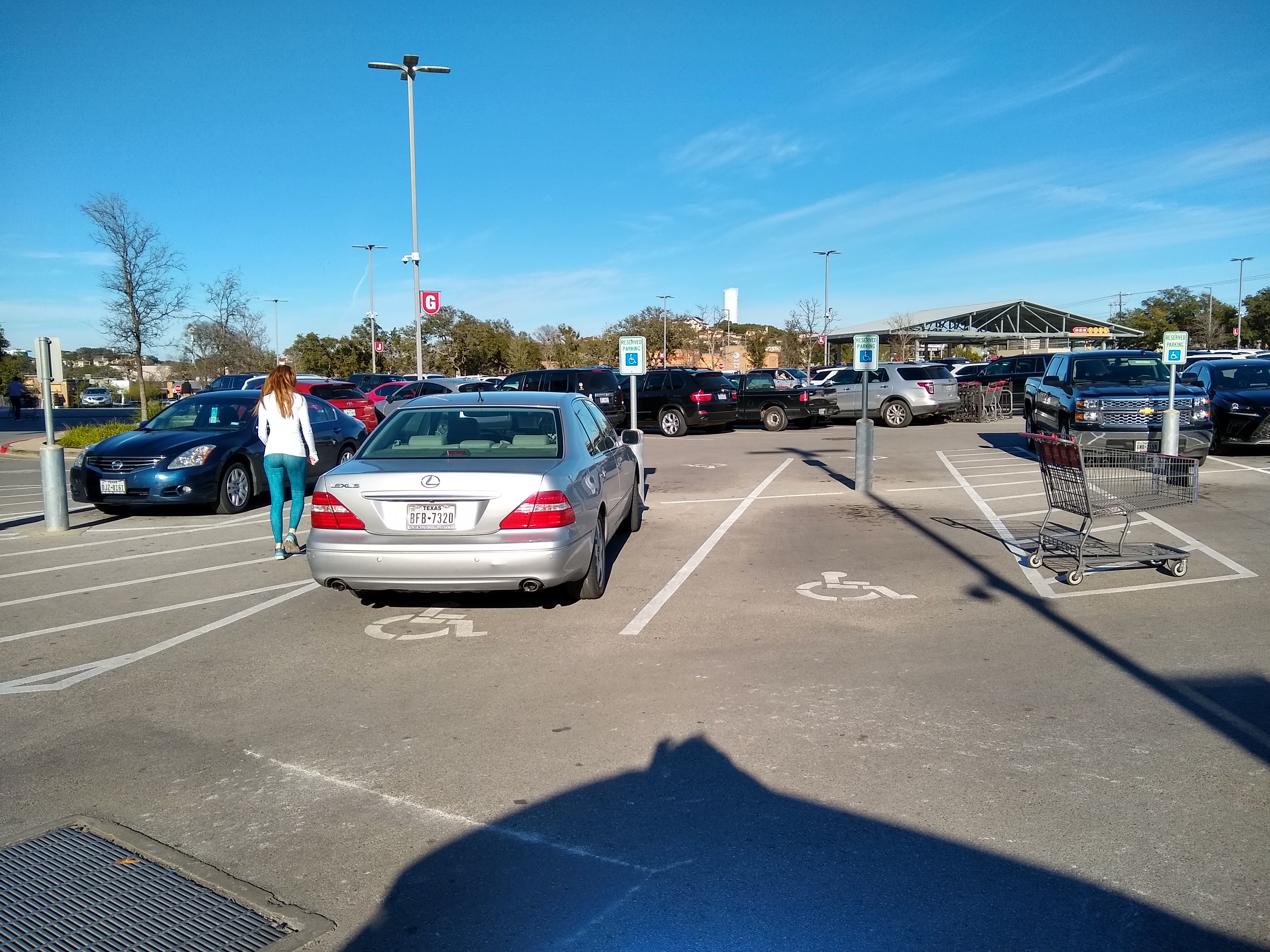
EXHIBIT 5
How is the constable’s term LOADING ZONE any different from Texas’ ACCESS AISLE? What extra information is the constable adding here? Is the constable claiming that the entire striped area is a so-called LOADING ZONE that is an architectural improvement? I won’t argue that the parking lot striping is an architectural improvement. You can call it a LOADING ZONE or a STRIPED AREA or whatever you want, but the real question is” is it an architectural improvement designed to aid persons with disabilities? Let’s examine this claim closely! To determine this, we need to clearly understand the physical setting. Exhibit 4 is a diagram of the actual location on the date of the incident. Exhibit 5 is a photo in the same orientation. The dimensions in Exhibit 4 are 100% accurate as I measured with an actual tape measure on Jan 20, 2019. The car icon is used to provide proportion. The placement of the motorcycle icon was accomplished with the photos provided as evidence from the prosecution. Please feel free to place the motorcycle icon better if you desire, since it’s placement with respect to the parking striping is the crux of this case. Exhibit 6 is a photo of the same area where my motorcycle was parked. I line up four HEB shopping carts to give an true representation of the size of the area of the striping. The wheelbase of each shopping cart is 30 inches.

EXHIBIT 6
Striping can be applied for many reasons other than marking for disabled parking spaces, as you have probably seen for yourself. For example, when you are are driving thru a parking lot and see striping, does that automatically mark a handicap zone? Of course not. Most times the striping is only for managing traffic. Often you see striping at the end of rows of parking spaces where there is not enough room to park one more full-sized car. Quite often, you see motorcycles parked in those striped spaces as shown in Exhibit 1.
Why do motorcyclists park this way, you may ask?
Some citizens condemn motorcyclists for parking this way. Most do not. It is NOT illegal. But there is no doubt that some think it should be illegal.
So maybe you still think that this parking lot striping is an architectural improvement that is designed to aid the diabled. If you do, look closely at Exhibits 4 and 5 and you will notice that the HEB shopping cart corral was placed by HEB over the very same parking lot striping! You might wonder, shouldn’t the constable be concerned about this much larger violation too?

EXHIBIT 7
But still, you may say that HEB is violating the law, and two wrongs don’t make a right. To respond to that concern, let me tell you that in the process of measuring dimensions with a tape measure to produce Exhibit 4, I attracted the attention of the manager of HEB. His name is Mike. Mike came outside and I explained my entire case to him and that HEB might be violating the law also. I can’t tell you what Mike said without putting him on the stand, however, a four days later I went back to double-check measurements. The shopping cart corral was moved even further onto the parking lot striping, as shown in Exhibit 7. Do you think that Mike did NOT consult the HEB law department before moving the shopping cart corral, especially after I told him what happened to me?
CLICK HERE FOR EXHIBIT 8 (PDF)
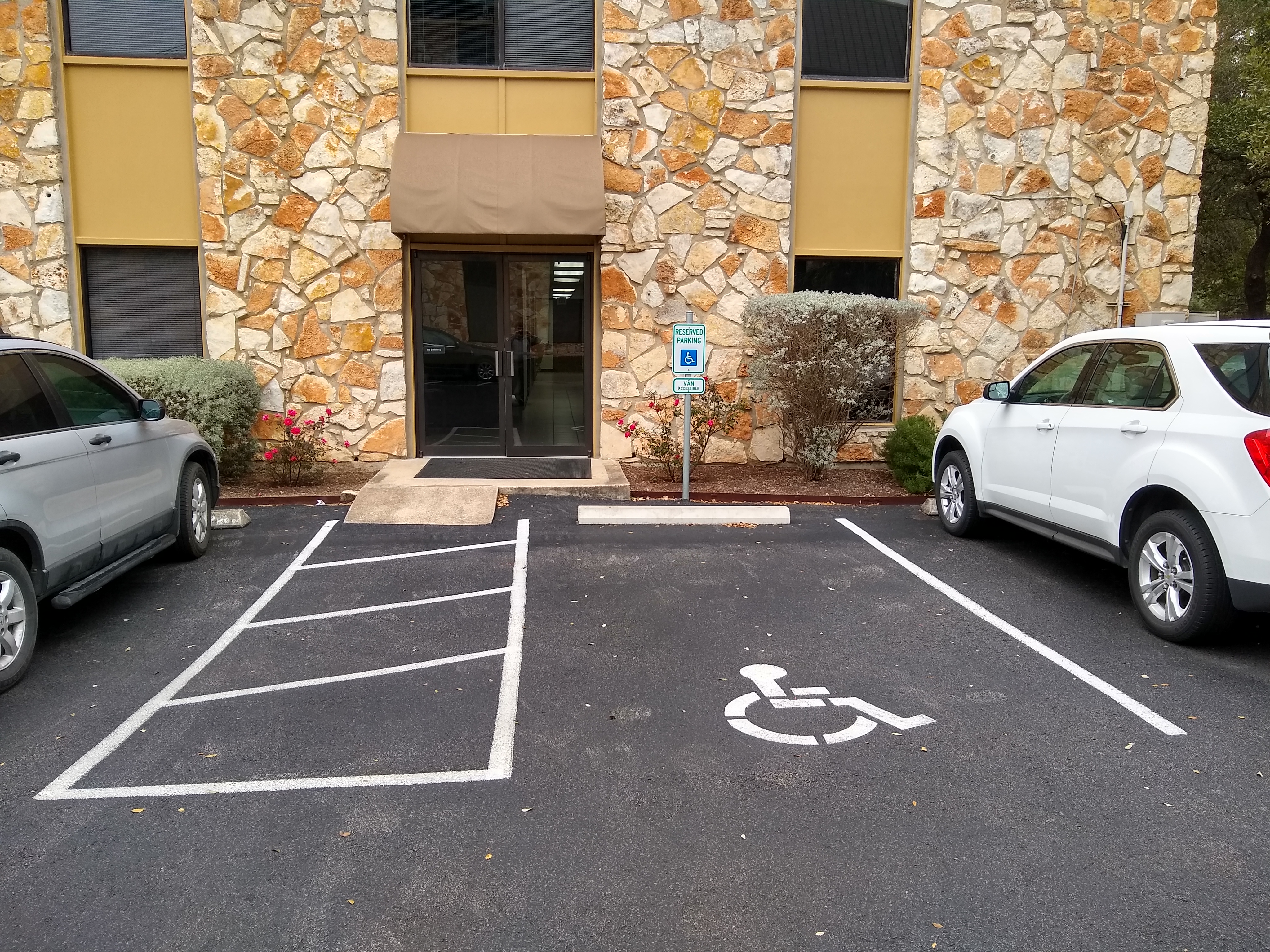
EXHIBIT 9
So, clearly, the striping is not an architectural improvement that was designed to aid persons with disabilities, such as an access aisle, per 681.011c. But you may ask, what does a true access aisle look like? Exhibit 8 is from Figure 502.3 p. 111 of the Texas Accessibility Standards which can be found online right now. It defines a Parking Space Access Aisle very explicitly. Specifically, the minimum width of an access aisle is only 60 inches, or 5 feet. (You will notice that the words LOADING ZONE are not used anywhere.) For your reference, a photo of an actual implementation is shown in Exhibit 9.
Let’s move on and assume that the striping is not an architectural improvement designed for the aid of disabled persons. You might wonder whether my motorcycle blocked any access aisle that could have been there and properly designed.
Please refer to Exhibits 4 and 5 where you will see a properly designed access aisle on the right. For proportion, an HEB shopping cart was placed along the width of the access aisle. Recall that the wheelbase is 30 inches. Now in your mind’s eye, imagine placing this properly designed access aisle on the left where the person is standing in Exhibit 5. The result is depicted as the dotted line in Exhibit 4. It is extremely important for you to notice that the diagonal striping lies about 2 feet to the left of the dotted line. (Point this out!) Now look at the prosecutions photo evidence. My motorcycle is clearly to the left of where the diagonal striping intersects the horizontal striping. Please view the prosecution’s photos. It is visually unequivocal that my motorcycle lies far outside where the access aisle would have been, if it were designed properly.
To reiterate, these parking stripes were not designed to be an access aisle. But furthermore, my motorcycle was not parked in the area that a properly designed access aisle would have cover. Therefore I did not block anything. So 681.011c was not violated in at least TWO aspects!
Let me appeal to your common moral sense. Why was a complaint filed at all? I parked in a spot that countless motorcyclists have been parking without seeing a single ticket for years. Like them, I have always left ample room for the adjacent disabled parking space, enough space to open a door and unload three wheelchairs abreast! Why do so many other motorcyclist agree with me? Are we all uncaring criminals?
In my opinion, the Volunteer Constable was called to serve that Saturday morning of the Memorial Day weekend, in an effort to provide a “show of force” rally to the public for the Memorial Day weekend. I noticed many other police offers on the way to HEB that day. In the excitement of this rally, the Volunteer Constable perceived the striping as an architectural improvement designed to aid the disabled and proceeded to ticket me. But a few days later when she wrote up the complaint, she created the term LOADING ZONE to try to shoehorn me into the 678.011c shoe. The Volunteer Constable hopes you will agree with her creativity. But HEB does not agree. The state of Texas does not agree either: there is no mention of a LOADING ZONE in all of Texas Law Section 681. The bottom line is: this is the Volunteer Constable’s opinion, nothing more and nothing less. It is not the law.
Perhaps the constable frequents that HEB often and observes motorcycles parking on that striping and has formed a strong opinion against such parking. Did the Volunteer Constable receive any specific training on the definition of an access aisle? The constable might be believe that merging a civil traffic ticket of “parking in a loading zone” with 681.011c is perfectly OK.
681.011c a criminal offense. To put the seriousness of a Class C misdemeanor in perspective, here are other Class C offenses in Texas: Assault Shoplifting Trespassing Leaving a child in a car Writing a “hot check” Jumping bail Possession of drug-related paraphernalia You may be aware that blocking an access aisle was not always a crime. Instead it was a civil infraction, at the level of a parking ticket. Why did 681.011c become a crime? Clearly, there were egregious violators that blatantly parked in disabled parking spots, forged placards, and the like, and would just pay a traffic ticket. That is immoral and so the Texas legislature rightfully increased the civil infraction to the criminal level. We all get that.
But has parking even near where the access aisle could have been, become crime? Respected jurors, you have the power to not let it.
I am going to assume that you have a pretty good idea of what encryption is. You probably encoded messages as a kid during school lectures by swapping letters of the alphabet, then sent them to your buddy. Then you sent the message and your classmate decoded them. Your other classmates didn’t have the key so they could not read the message.
But why would I want to use encryption over just sending a message in the clear? Remember the “CIA”: confidentiality, integrity, authenticity.
Confidentiality – none of your classmates can read your message except your buddy
Integrity – none of your classmates can change the message
Authenticity – your buddy knows for a fact that the message was sent by you
I will spare you the history and math, and just say that you need a key to encode a message and decode a message. It’s like a key you use to lock a vault. It’s called a symmetric key and it’s very simple to understand. To use the key, you will need to meet with your buddy and share the symmetric key prior to using the key to encode/decode a message.
But what happens when you want to send a message to a new buddy without sharing a symmetric key prior? Clearly, if you send the symmetric key it can be intercepted and used by your classmates to decode your message! To solve this problem, we need a new type of key.
This special type of key is actually a pair of keys! One key undoes what the other key did. So if one key encodes, the other key decodes. If you are the thoughtful type, you might want to take some time off and thing about what you could do with this new pair of keys. It’s a game changer. Here’s one thing…. Suppose your vault (see above) now has a special lock that uses this pair of “inverse” keys. Suppose your buddy had one and you had the other. Then if you came upon this vault and it was locked, then you would know that only your buddy could have locked it, and only you could unlock it. You would know that anything in the vault would necessarily have to put there by your buddy. Conversely, if you came upon the vault and it was unlocked, then you could put something in that vault, lock it, and then only your buddy could open it and know it was put there only by you. Is that not profoundly cool or what? This type of key is called an asymmetric key.
Let’s apply this asymmetric key pair idea to the next level. Suppose you have an asymmetric key pair and you tell everyone one of those keys publicly. But you keep the other key secret and private. What does that private/public key pair get you? Well, if you encode a message with your private key, anybody can decode it with your public key, right? (Just like the vault example above.) This is the main point so make sure you see this before proceeding. This public/private key arrangement does not ensure confidentiality, after all, everyone has your public key, including your buddy. But it does ensure integrity and authenticity because the public key only undoes the encoding you did with your private key. If your public key works on decoding a message, it MUST have come from a message encoded by your private key. So your buddy know that your message MUST have come from you!
But there is still a problem in the security here. What if one of your classmates, a real jerk, tells everybody HIS public key, but says its YOURS? You can see that your buddy will be reading a message and he will be thinking it was from you but it is real from the jerk! How do we handle this? To answer this, we need to understand what a certificate does.
Anyone can make a certificate, which simply certifies that a public key belongs to someone. Suppose my little sister wants me to certify her public key, and I make a certificate. Then if a class mate trusts my certificate, then they will trust her public key to use. How do I make a certificate? It is easy! All I do is encode her public key with mine! That is all there is to it. But you might see a problem: how does a classmate trust mine in the first place? It sound circular but it is not… I give him a certificate that certifies me! It turns out that the teacher wrote a certificate for me, and certainly all my classmates trust the teacher, right?
That’s about as far as I can take the teacher/classroom analogy. You can see that the teacher is a trusted person, and if he says that my public key is such and such, then yo u believe him and can rest assured that my public key you are using is not from that jerk. Such trusted persons are called Certificate Authorities (CA) and there are many corporations out there that you can trust to provide true certificates that their vetted customers register.
That’s about all their is conceptually about using encryption. The entire trust network of certification is called the public key infrastructure, or PKI. It can be very complex to understand the software implementation of all this, especially in browsers and http reply/response, but you are now in the know now about the general how and why you would use encryption.
P.S. As an exercise, how would you apply the above asymmetric key concepts to send a symmetric key confidentially? (It turns out that symmetric keys encode and decode much faster, so if you are going to do a lot of communication, yo uwill want to use a symmetric key, and actually, this is exactly what TLS handshakes do in your browser.) Here is an answer. Using the CA, get the public key of your desired recipient and use it to encrypt a message. As we have learned, only the desired recipient will be able to decode it. What will this message contain? It will be the symmetric key you want to share using your private key. If you comprehend why this double encryption trick works, you have graduated!
When we are born, we are innocent and empty vessels. They fill our minds with their best guesses, and most of us choose to believe them. But others recognize that they are indeed just best guesses, so despair and succumb to nihilism. Just a few see the innocence regained and able to see the world like they once did.
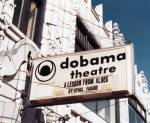 I used to volunteer at the Dobama Theater in Cleveland Heights for props under Mary Walsh from 1991-1995 starting at the show Hunting Cockroaches starring Diane Bradley. What an incredible experience! I did some lights then finally some acting for the Children’s Festival as an FBI agent. I had to do a stage entrance by tumbling; I ripped open my pants and almost forgot my lines, but got thru it with flying colors. The show ended with Pachebel’s Canon, which I had never heard before. It was beautiful so I asked Mary what it was and I think she said “Taco Bell’s Cannon”.
I used to volunteer at the Dobama Theater in Cleveland Heights for props under Mary Walsh from 1991-1995 starting at the show Hunting Cockroaches starring Diane Bradley. What an incredible experience! I did some lights then finally some acting for the Children’s Festival as an FBI agent. I had to do a stage entrance by tumbling; I ripped open my pants and almost forgot my lines, but got thru it with flying colors. The show ended with Pachebel’s Canon, which I had never heard before. It was beautiful so I asked Mary what it was and I think she said “Taco Bell’s Cannon”.

Well, that chord progression stuck with me and well it should! It’s stuck with many since its creation in the early 1600’s, about the time of Sir Isaac Newton! Now, given that I am learning guitar, I thought that I’d learn it, but in every key. Here is the chart.
The top line in the key of C is the easiest. But every new line introduces you to a new chord. Some are barre chords. But most importantly, the new chord is “exactly the same but different” and you will be amazed at the patterns that you see develop as you learn each line. For example the F chord on the guitar is just a barred E chord. Duh, it’s obvious now, but until I started making my way thru the challenge, I didn’t see it. And the revelations continued for me.
I was expecting that the overall Pachelbel sound would be conserved across keys. It generally is, but each key has it’s own characteristic sound. Try it!
You might think that the Pachebel chord transition would map out on the circle of fifths in some beautiful way. It does orbit near the root, but it doubles back and there are discontinuities that Pythagorus would disapprove of. No sexy geometry here.
1111111111Go figure.
HackerRank says this is easy, and it is.
John has discovered various rocks. Each rock is composed of various elements, and each element is represented by a lower-case Latin letter from ‘a’ to ‘z’. An element can be present multiple times in a rock. An element is called a gem-element if it occurs at least once in each of the rocks.
Given the list of rocks with their compositions, display the number of gem-elements that exist in those rocks.
Input Format
The first line consists of an integer, , the number of rocks.
Each of the next lines contains a rock’s composition. Each composition consists of lower-case letters of English alphabet.
Constraints
Each composition consists of only lower-case Latin letters (‘a’-‘z’).
length of each composition
Output Format
Print the number of gem-elements that are common in these rocks. If there are none, print 0.
Sample Input
3
abcdde
baccd
eeabg
Sample Output
2
Explanation
Only “a” and “b” are the two kinds of gem-elements, since these are the only characters that occur in every rock’s composition.
import java.io.*;
import java.util.*;
public class Solution {
public static void main(String[] args) {
Scanner scanner = new Scanner(System.in);
int T=scanner.nextInt();
Set<Character> allCs = new HashSet<>();
List<Set> sets = new ArrayList<>();
for (int t=0; t<T; t++) {
char[] cs = scanner.next().toCharArray();
Set<Character> set = new HashSet<Character>();
for (char c : cs) {
set.add(c);
allCs.add(c);
}
sets.add(set);
}
int total=0;
for (char c : allCs) {
boolean gem = true;
for (Set set : sets) {
if (!set.contains(c)) {
gem = false;
break;
}
}
if (gem) {
total++;
}
}
System.out.println(total);
}
}
Reply